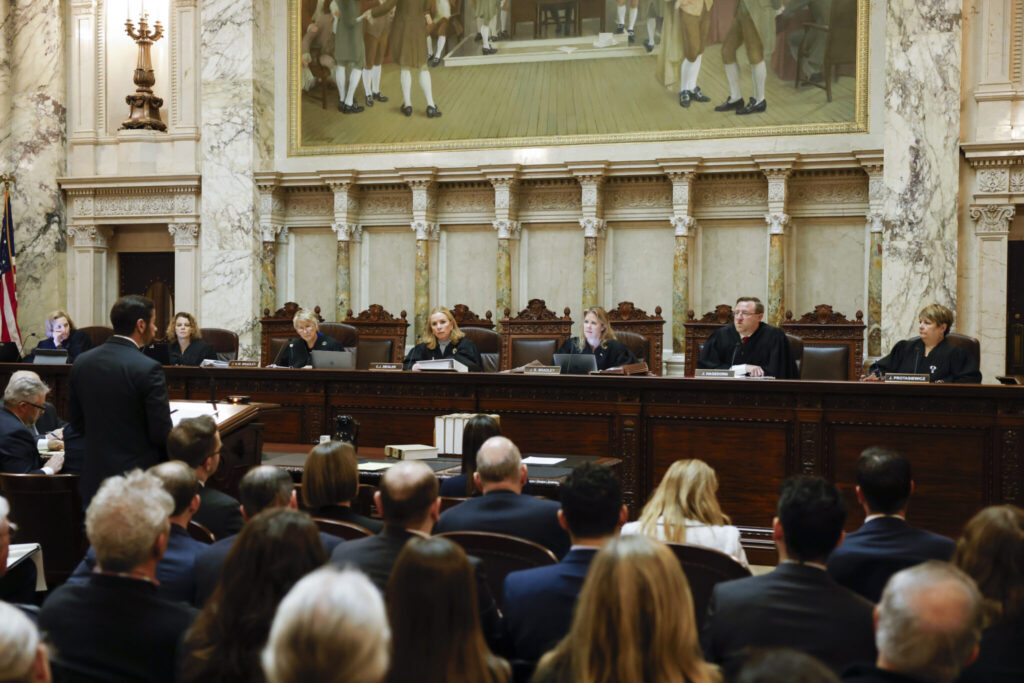The liberal-controlled Wisconsin Supreme Court overturned Republican-drawn legislative maps on Friday and ordered that new district boundary lines be drawn as Democrats had urged in a redistricting case they hope will weaken GOP majorities. The ruling comes less than a year before the 2024 election in a battleground state where four of the six past presidential elections have been decided by fewer than 23,000 votes, and Republicans have built large majorities in the Legislature under maps they drew over a decade ago.
Quick Read
- Wisconsin Supreme Court’s Ruling on Legislative Maps:
- Decision: Overturned Republican-drawn legislative maps.
- Majority: Liberal-controlled court (4-3 vote).
- Reason: Districts drawn are unconstitutional for not being contiguous.
- Implications for 2024 Elections:
- Background: Wisconsin is a battleground state with close presidential elections.
- GOP Majorities: Built under the maps drawn over a decade ago.
- Legal Proceedings and Next Steps:
- Court’s Directive: Enjoin Wisconsin Elections Commission from using current maps.
- Requirement: Adoption of new district boundary lines as urged by Democrats.
- Potential: Court to adopt remedial maps for 2024 elections if GOP-led Legislature and Gov. Evers don’t agree on new maps.
- Reaction and Comments:
- Plaintiffs: Celebrated ruling as a victory for representative democracy.
- GOP Response: Attorneys for the Legislature and Republican leaders did not return messages.
- Court’s Plan for New Maps:
- Submission: Parties of the lawsuit can submit new maps.
- Evaluation: Court-appointed consultants to assess maps.
- Context of Court’s Liberal Majority:
- Shift: Occurred after Justice Janet Protasiewicz’s election in April.
- Impeachment Threats: Republicans threatened impeachment over Protasiewicz’s campaign comments.
- Dissenting Opinion:
- Justice Ziegler: Criticized majority for overstepping constitutional responsibilities.
- Accusation: Judicial activism, undermining law and other government branches.
- Comparison with Michigan Ruling:
- Similar Case: Federal judicial panel ordered redrawing of Michigan state House and Senate districts.
- Timeframe for New Maps:
- Elections Commission Deadline: March 15 for 2024 election readiness.
- Debate: Timing of implementing new maps, whether to include state Senate members in mid-term.
- Republicans’ Legislative Control:
- Current Majority: Significant in both Assembly and Senate.
- History: Enacted conservative policies, limited Governor Evers’ agenda.
- National Context:
- Ongoing Litigation: Redistricting cases in over a dozen states post-2020 census.
The Associated Press has the story:
Wisconsin SCOUT orders new legislative maps in redistricting case brought by Democrats
Newslooks- MADISON, Wis. (AP)
The liberal-controlled Wisconsin Supreme Court overturned Republican-drawn legislative maps on Friday and ordered that new district boundary lines be drawn as Democrats had urged in a redistricting case they hope will weaken GOP majorities.
The ruling comes less than a year before the 2024 election in a battleground state where four of the six past presidential elections have been decided by fewer than 23,000 votes, and Republicans have built large majorities in the Legislature under maps they drew over a decade ago.
The court ruled 4-3 in favor of Democrats who argued that the legislative maps are unconstitutional because districts drawn aren’t contiguous.
“Because the current state legislative districts contain separate, detached territory and therefore violate the constitution’s contiguity requirements, we enjoin the Wisconsin Elections Commission from using the current legislative maps in future elections,” Justice Jill Karofksy wrote for the majority.
Dan Lenz, an attorney for Law Forward, which brought the lawsuit, called the ruling “a victory for a representative democracy in the state of Wisconsin.”
“For too long, rightwing interests have rigged the rules without any consequences,” he said in a statement. “Gerrymandered maps have distorted the political landscape, stifling the voice of the voters. It challenges the very essence of fair representation and erodes confidence in our political system.”
Attorneys for the Legislature and Republican leaders did not return messages.

The court said it will proceed with adopting remedial maps in time for the 2024 election unless the Republican-controlled Legislature can pass maps that Democratic Gov. Tony Evers will sign. Evers vetoed the current maps.
All of the parties of the lawsuit will be allowed to submit maps to the court, along with expert evidence and supporting arguments. The court said it will appoint one or more consultants to evaluate the maps who will issue reports on their findings.
The lawsuit was filed a day after the court’s majority flipped to 4-3 liberal control in August. That’s when Justice Janet Protasiewicz joined the court after her April election victory.
Protasiewicz called the GOP-drawn maps “unfair” and “rigged” during her campaign, leading Republicans to threaten to impeach her before she had even heard a case. She sided with the other liberal justices in striking down the current maps.
Republican Assembly Speaker Robin Vos, who had threatened impeachment the loudest, backed off on Wednesday and said even if she ruled in favor of throwing out the maps, impeachment was “super unlikely.”
She joined with Karosfky and justices Ann Walsh Bradley and Rebecca Dallet in the majority. Conservative justices Annette Ziegler, Rebecca Bradley and Brian Hagedorn dissented.

“This deal was sealed on election night,” Ziegler wrote in her dissent. “Four justices remap Wisconsin even though this constitutional responsibility is to occur every ten years, after a census, by the other two branches of government. The public understands this.”
She accused the majority of “judicial activism on steroids.”
“The court of four takes a wrecking ball to the law, making no room, nor having any need, for longstanding practices, procedures, traditions, the law, or even their co-equal fellow branches of government,” Ziegler wrote.
Wisconsin’s redistricting ruling comes one day after a federal judicial panel also struck down some of Michigan’s state House and Senate districts and ordered them to be redrawn. The Michigan court said the districts were illegally drawn based on race.
The ruling comes one month after the court heard oral arguments in the case in November. The state elections commission has said maps must be in place by March 15 if the new districts are to be in play for the 2024 election.
Democrats argued for having all 132 lawmakers stand for election under the new maps, including half of the members of the state Senate who are midway through their four-year terms. The Legislature argued that no new maps should be enacted any sooner than the 2026 election.
Democrats argued in Wisconsin that the majority of current legislative districts — 54 out of 99 in the Assembly and 21 out of 33 in the Senate — violate the state constitution’s contiguity requirement.
Wisconsin’s redistricting laws, backed up by state and federal court rulings over the past 50 years, have permitted districts under certain circumstances to be noncontiguous, attorneys for the Legislature argued. Even if the court decided to address the issue, it could only affect alleged areas where districts aren’t contiguous and not upend existing district lines, Republicans argued.
The legislative electoral maps drawn by the Republican-controlled Legislature in 2011 cemented the party’s majorities, which now stand at 64-35 in the Assembly and a 22-11 supermajority in the Senate.
Since taking the majority in 2011, Republicans have enacted a wide range of conservative priorities. They have all but eliminated collective bargaining for public workers, and since 2019 they’ve been a block on Evers’ agenda, firing Evers appointees and threatening impeachment of Protasiewicz and the state’s elections leader.
Republicans are also just two seats short of a supermajority that would allow them to overturn Evers’ vetoes.
Litigation is ongoing in more than dozen states over U.S. House and state legislative districts enacted after the 2020 census.






